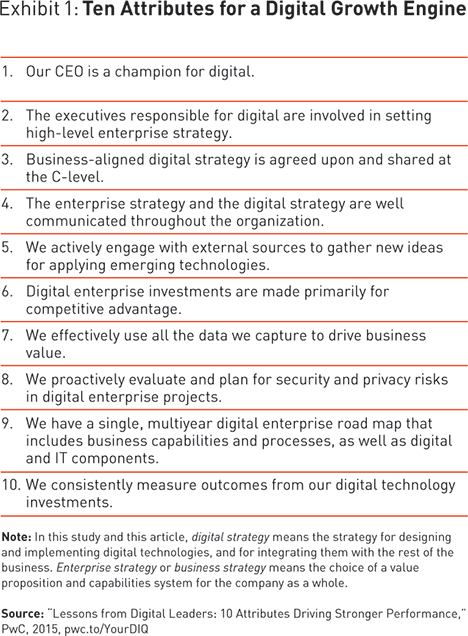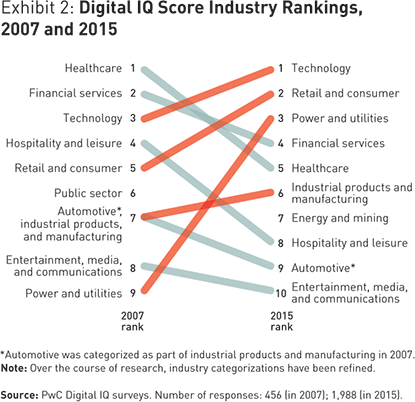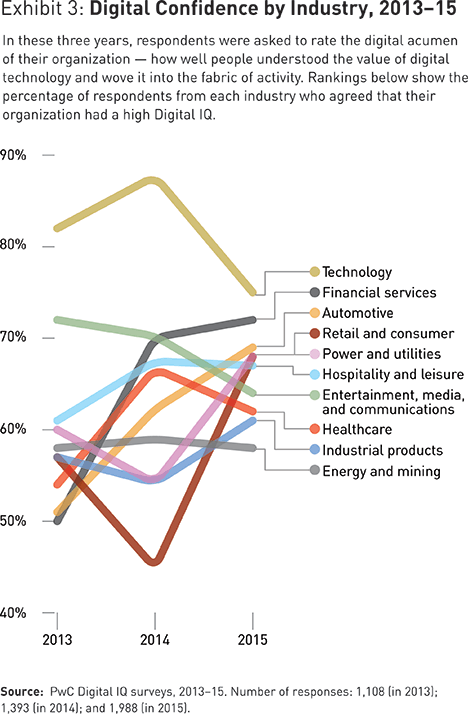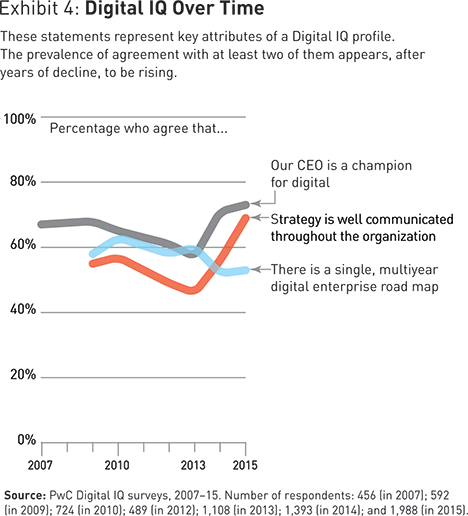Raising Your Digital IQ
A global survey of business leaders shows how the smartest companies develop and wield their technology strategy.
Like most other executives today, Thomas Okke Frahm thinks about how his organization can better exploit digital technology. But the biggest challenge he’s pondering at the moment doesn’t involve engaging customers through mobile devices, migrating applications to the cloud, or even beefing up cybersecurity. He’s thinking about cheese.
Frahm is the vice president of global IT management at Chr. Hansen, an €859 million (US$940 million) multinational bioscience company based in Denmark. It produces natural food ingredients, microbiological cultures, and probiotics, mostly for consumer packaged goods companies such as food manufacturers. Now, Chr. Hansen is exploring the ways that sensors can help clients perfect their processes for making cheese, yogurt, and other foods that rely on cultures and enzymes. These foods are consumed by hundreds of millions of people daily.
Chr. Hansen (pronounced “Christian Hansen,” after the full name of its founder) has been operating continuously since 1874. One of the world’s oldest companies, with a heritage of consistent innovation, it is now being challenged by digital technology to leap ahead of its old ways of doing business. In the cheese-making project that Frahm oversees, sensors capture data about the pace and quality of bacteria development, thus improving production yields. Frahm says that consumer packaged goods companies could subscribe to this granular view of these processes as a digital service. But would they pay for it? A similar effort last year stalled; customers weren’t ready.
Nor is Chr. Hansen fully ready itself, despite its strong embrace of digital technology. It is still figuring out how to bridge the gap between the petri dish and the production floor. “We [have been] a very traditional company,” says Frahm. “We have big silos between innovation and production.... If I can combine the two things, then we can be even faster from idea to final product.” He adds that the new digital technologies are eroding the value of old intellectual property. In the future, “it is the speed of innovation that’s going to matter.”
New digital technologies are eroding the value of old IP. In the future, “It is the speed of innovation that’s going to matter.”
Most business leaders have reason to agree. The acceleration of digital technology — and its effect on evolving capabilities, data proliferation, customer expectations, and seemingly everything else — is affecting all industries. Industrial companies such as Caterpillar, Deere and Company, and Siemens are analyzing immense amounts of data gleaned from the movement of their equipment in the field; power utilities such as Pacific Gas & Electric are building business models around the “grid of things”; publishers such as Axel Springer are migrating to online journalism platforms; banks such as Citi and Standard Chartered are reconceiving their customer interactions around the smartphone; specialized retailers such as Warby Parker are designing innovative multichannel boutiques that allow customers to try on purchases at home; and a few companies, such as Haier, are self-consciously redesigning their organizational structure to evoke Internet-style connectivity. From the front line to the corporate board, the push is on for each business to be reborn as a “digital company.”
What exactly that means is not the same for every business, nor should it be. Thus, if you are a senior executive developing a digital strategy, the first thing you need is a way to gauge whether that strategy is smart: whether it puts today’s technology to work in an appropriately advanced way, while being a good fit for your overall strategy and your way of doing business. In short, you need to check your Digital IQ — and if necessary, to raise it.
Attributes of Digital Prowess
The effectiveness of the use of digital technology has been a subject of research at PwC since 2007, when business technology was equated with back-office systems and well before digital became a corporate buzzword. For nine years, our Digital IQ study has examined technology strategy, practices, and attitudes by surveying hundreds of business leaders. The respondents include both senior technology executives — those with titles such as chief information officer (CIO) and chief technology officer (CTO) — and overall business leaders such as CEOs and other top executives. During all the years of research, a high Digital IQ has always signified the same thing: the ability to consistently make the kinds of digital investments that deliver and sustain value. Achieving it requires technological acumen, but not just on its own; it must be linked to a clear strategic direction for the enterprise.
In our most recent study, conducted in fall 2015, we analyzed data from nearly 2,000 executives, representing 10 industries (and 51 countries). As we did in our inaugural study, we developed an index of digital prowess, analyzing 26 factors and isolating those that were most strongly correlated with higher levels of financial performance. The organizations in our study that embraced these practices were twice as likely to achieve rapid revenue and profit growth as other companies in our study.
The resulting list of 10 attributes that make up our Digital IQ score was hardly a surprise (see Exhibit 1). In our research, we have repeatedly observed the same crucial factors in companies with effective digital strategies. These fundamentals have never been more important than they are today, when technological prowess is a matter of survival. Meanwhile, many companies are becoming more mature in their digital focus. They have already used technology to improve productivity and wring out costs. Now they are using it to grow revenue, create compelling customer experiences, and build the kinds of distinctive capabilities that lead to ongoing success.
The results are evident in the Digital IQ rankings of industries (see Exhibit 2). In 2007, the gap between the most effective digital industry (healthcare) and the least (power and utilities) was 20 percent. Since then, performance has improved across the board, with only a 5 percent margin separating today’s highest-ranked industry (technology) from its lowest-ranked (entertainment, media, and communications). Technological transformations are taking place in every sector. In healthcare, hospitals have broadly adopted electronic health records in the name of enhanced patient quality; industrial companies have made major investments in comprehensive Internet of Things–style platforms that can improve the way wind turbines, jet engines, and other large-scale machines are used.
This improvement correlates with an overall rise in digital confidence, albeit with some industries excepted. Since 2013, we have asked respondents to rate the strength of their organization’s digital acumen. In 2015, two-thirds of them said they had a strong or very strong Digital IQ. This percentage had risen about 2 percent during each of the previous two years. The fact that a majority are paying attention, and that they are generally increasing their effectiveness, is welcome news (see Exhibit 3).
Fully two-thirds of the executives we surveyed rated themselves as having a high Digital IQ in 2015.
But there is a powerful countervailing force. The technological environment in which most businesses operate continues to grow more complex and competitive, at an ever-faster pace. It’s not just the competition from innovative, well-funded startups that causes upheaval. It’s also the response within established incumbents as they feel the pressure of digital technology. Three examples follow.
• New spending patterns. Budgets are shifting to reflect the new realities in IT: lower costs with cloud-based services, digital technology that permeates every aspect of the business, and business leaders’ increased awareness of the art of the possible. Business units accustomed to depending on shared functional resources for, say, mobile customer apps now feel free to engage outside resources to develop their own. Departments can opt for pay-as-you-go collaboration services instead of investing in stand-alone systems, and functions such as marketing have their own tools with which to collect, analyze, and act upon data. In 2015, the majority of technology spending (68 percent) came from budgets outside the IT organization, a significant increase from 47 percent the prior year. Although the democratization of technology across an organization is generally a good thing, it can have such unintended consequences as duplicative efforts, incompatible systems, inadequate attention given to cyber-risks, and off-strategy investments.
• New digital leadership. Enterprise technology used to be the sole domain of the IT function, led by the CIO. Now there is a trend toward broader-based oversight. Some companies are expanding the CIO role to foster a more direct connection between technology and strategy. Other companies are creating a chief digital officer (CDO) or similar role to lead digital transformation efforts. In some companies, titles for leaders who oversee digital strategy include the chief experience officer and chief data scientist. This trend focuses C-suite attention on a company’s Digital IQ, which is valuable; however, it also adds to potential uncertainty regarding responsibilities and governance. (See “The New Chief Digital Officer,” by Roman Friedrich, Pierre Péladeau, and Kai Mueller.)
The New Chief Digital Officer
by Roman Friedrich, Pierre Péladeau, and Kai Mueller
More than a quarter of the world’s population owns a smartphone. In 2014, global mobile data traffic reached 2.5 billion gigabytes per month, a figure that is 30 times as large as all the traffic on the Internet for the full year 2000. No wonder global companies are moving rapidly to reshape their businesses to meet this new level of connectivity. One way they are doing so is by appointing a new kind of executive, the chief digital officer (CDO). The CDO’s mandate: to equip companies for the digital future. This executive has the dual task of developing an all-inclusive digital experience for customers and the internal capabilities needed to support that experience — while simultaneously managing the considerable investment required. The emergence of the new role to lead the organization’s digital efforts may in part be a reaction to the chronically weak relationships between CIOs and CMOs, which we’ve observed over the last few years.
The number of companies that have hired CDOs remains small — just 6 percent globally, according to the results of the inaugural Strategy& study of digital leadership at 1,500 of the world’s largest companies. But the number is growing rapidly. Of the 86 CDOs we found, 31 were appointed in 2015. The sectors where the highest proportion of companies have CDOs are travel and tourism, with 31 percent; entertainment, media, and communications companies, with 13 percent; and food and beverage companies, with 11 percent. At the other end of the spectrum, only 1 percent of mining and metals companies had a CDO; just 2 percent of those in the automotive, machinery, and engineering sectors did; and only 3 percent in technology and electronics did. One is also more likely to see CDOs in European companies than in their U.S. or Asian counterparts, and CDOs are more likely to appear in large companies than small ones. We suspect that in many cases where a CDO has not been appointed, it is because the related responsibilities are already distributed among other top management roles and are entrenched in all aspects of the company’s culture.
In the past, traditional CIOs and CTOs were focused primarily on their companies’ IT, managing employee desktops and enterprise-wide ERP and CRM systems. The CDO role, although it varies from one company to another, is far more comprehensive. Besides customer experience, the development of digital features in new products and services, and the relevant operational changes, the CDO may oversee changes in technical infrastructure and innovations in data collection and analysis. The CDO must also be an agent of cultural change, championing the digital transformation throughout the company and linking it to the development of the distinctive capabilities that form the basis of a company’s strategy.
Here are glimpses of chief digital officers (or people in similar roles) at four major companies, and the ways in which they meet the challenge of digital transformation.
Jessica Federer is head of digital development at Bayer. “The data piece is actually the easiest,” she notes. “Data is data. It’s the people piece that’s the challenge. So we focus first on the people in the organization, and how we connect across synergies, across silos, over platforms and data.”
Soon after she was appointed, Federer created a digital council consisting of the CIOs and CMOs of the relevant divisions at Bayer. Their task was to look at potential synergies. She also fostered a huge network of people involved in some aspect of digital transformation, to which she gave the acronym NERD (Network for Enterprise Readiness and Digital). “They bring together digital marketing with digital product supply with digital R&D,” says Federer. “We used to do this in silos, but now we do it by sharing information.”
At Renault, CDO Patrick Hoffstetter is creating a centralized digital transformation organization, which he calls the Digital Factory. This is not a literal factory, but a metaphorical center for people throughout the company who already work on digital projects and another group working at about 65 outside suppliers. The factory is the nexus of communications about the digital strategy, and the place where resources and experts come to design the transition to what Hoffstetter calls “the connected employee.” The changes put into place at the Digital Factory will affect how people work, what they expect from the company, and what tools they are given.
Balancing the timetable for this complex shift is a key part of the CDO’s role. “One reason most operations in digital strategy and transformation are focused on sales and marketing is that these functions have a direct, quite short-term impact on the business,” says Hoffstetter. “Whereas when it comes to the evolution of internal processes, internal social networks, acceleration of collaborative tools, and internal training, it’s much harder to show any payback, and it takes a lot longer.”
Corinne Avelines, CDO of the decorative paints division of the Dutch chemical company AkzoNobel, says broad support is critical: “Commitment at the top management level to innovation and digitization has made my job considerably easier,” she says. “Senior support is key to ensuring commitment to digital at the company, especially one of this size.”
At the same time, she says, overall strategy must always drive decisions about how and what to digitize. “Gaining a competitive advantage in a fast-digitizing age is a challenge, so CDOs must understand their company’s current position and future strategy — what will make an impact on providing value to the customer — and focus on that. Worry about the other things later.”
Visa CDO Chris Curtin says that he has learned to participate actively in the creation of the overall business strategy — and lead the process when necessary. “I not only think that the best CDOs are reflective of the business,” he says, “I think that in many respects they are the business.” To that end, he believes that CDOs should “forget about digital. Forget about new media. The business objective has to permeate the thinking and the strategies and the go-to-market approach of the CDO and his and her team. Never make the means the end. A million followers on Twitter is just a means. The end is the business goal.”
The CDOs interviewed for this study all emphasized the importance of working closely with every function of the business. Being part of top management gives them a critical strategic perspective, but they must also be given the power and support they need from functional groups. Otherwise, they may find themselves with a seat at the table but without the strategic and operational input that the digital transformation needs.
Ultimately, the goal of every CDO is to ingrain the digital agenda so deeply and efficiently that it will become a way of life for everyone and every function in the organization, and a priority for every member of its C-suite. Sooner or later, companies may get to a point where a transformation isn’t necessary, because it has already happened. Digital technology will be so well integrated that it won’t be a separate issue anymore. It will simply be part of the way people work, and the CDO will move to some new type of challenge.
- Roman Friedrich is a leading practitioner with Strategy&, PwC’s strategy consulting business, and a partner with PwC Germany. He is based in Düsseldorf and Stockholm.
- Pierre Péladeau is a thought leader on digital strategy with Strategy& and a partner with PwC France, based in Paris.
- Kai Mueller is a specialist with Strategy& and a senior research and knowledge manager with PwC Germany, based in Berlin.
• A new digital debate. Every company has its own point of view about the value of digital technology and how it should be managed. Some of the executives we surveyed define digital as activities related only to the innovation of products and services. Others see it as integrating technology into all parts of the business. Still others say digital is merely a synonym for IT, and some use the term in reference to customer-facing initiatives or data analytics activities. Does this splitting of hairs over definitions really matter? It does if the CEO means one thing and members of the executive team hear something else, especially if it isn’t fully clear who is accountable for the digital strategy.
All this fluidity creates a considerable challenge for business leaders intent on capitalizing on digital technology. Thankfully, there are ways of raising your Digital IQ. You can integrate your digital strategy and business strategy, which means getting top leadership directly involved; you can redesign your innovation practices; and you can invest in a few critical forms of digital prowess, including data analytics, cybersecurity, and the building of a digital road map.
How to Activate Your Digital Growth Engine
How can you use Digital IQ to create competitive advantage? Consider these practices:
1. Diagnose your company. First, capture your own personal sense of where your company stands, for example, with the online assessment at pwc.to/YourDIQ. Then, retake the assessment with your business and IT leadership team. Look for gaps: For example, you may find, as one large industrial company did, that you are far ahead in managing cybersecurity and data analytics — but surprisingly behind in the way you communicate and develop your shared digital vision.
2. Conduct a digital strategy workshop. Bring together key leaders from around the enterprise to look at the results of your diagnosis, and to discuss the next wave of digital investments. Use the same workshop to raise awareness of other relevant issues, such as lack of coordination in your technology spending.
3. Start a digital dialogue. Use technology — video, internal social media, and mobile — to engage large numbers of employees about the digital strategy and ways to implement it.
4. Develop a disruption strategy. Look for customers who are not served by your current offerings. Take on the challenge of using digital technology to create a spin-off that meets the needs of these customers or matches their price point. If Clayton Christensen is right, this spin-off approach could grow one day to challenge your main business.
5. Expand your ecosystem. Digital innovation is emerging from places your organization may not frequent, such as startup incubators, university labs, open source projects, and “maker” communities. Build new relationships with these sources of knowledge to keep your ideas and skills fresh and flowing.
6. Shake up your leadership. Create or reshuffle your organizational roles so that the CIO, CMO, head of operations, and even CFO are aligned to the digital needs of your company. If need be, put a CDO (or equivalent) in place to tie all your initiatives together.
A Strategic Approach to IT
It’s relatively easy to understand the specifics of any technological advance. It’s much harder, and more crucial, to use that technology to make your company stronger — especially in a way that nobody else can copy. Breakthroughs in analytics, artificial intelligence, robotics, and other digital fields can revitalize your capabilities and thus enable new forms of growth, just as they are doing at Chr. Hansen. When you link your technology investments with your enterprise strategy, you get far more out of those investments.
The executives we surveyed recognize this. More than half said they explicitly integrate their digital strategy with their overall business strategy. About one-third say the two are kept separate. The remainder, less than 20 percent, say they don’t have a digital strategy, they don’t consider it when setting overall strategy, or they simply don’t know.
It’s easy to understand breakthroughs. It’s much harder, and more crucial, to use that technology to make your company stronger.
That’s why the engagement of top leadership is so important. Only the CEO or equivalent managing director can mandate that digitization be a comprehensive, unified, enterprise-wide priority directly linked to what makes the company successful. At companies such as Apple, Frito-Lay, and Haier, the chief executive is directly involved in technological decisions, especially those involving key products or processes.
At GE, CEO Jeffrey Immelt has been the technological leader of the company since he took office in 2001. Immelt has famously said that digitization will affect every corner of the economy, that every industrial company will soon be a software and analytics company, and that GE’s digital transformation is the company’s most important initiative since the mid-1980s. (See “Enterprise Architecture Planning 2.0,” by Jack Topdjian, Dirk Klemm, and Carl Drisko.) He is using $200 billion gained through major divestitures, such as the sale of GE Capital, to fund investment in new digitally enabled enterprises.
This sort of strategic approach to information technology is “one of the big opportunities of the coming 10 years,” he told interviewer Tim O’Reilly at Next:Economy, a gathering of management and technology leaders convened by O’Reilly Media in November 2015. “If [industrial companies] don’t grab this next wave of the information age, we’re not going to have the kind of productivity that is required to be competitive.”
At GE, two C-suite positions are devoted to the strategic use of digital technology. Chief digital officer Bill Ruh (in a role recently created) oversees digital business, which is what the company calls its line of industrial services and software, and CIO Jim Fowler manages the internal innovation required to generate new products and reinvent the company’s operations. Explains Fowler, “Between now and 2020, I’ve committed to delivering $1 billion of productivity across the General Electric Company through the use of technology. I’ve also committed to converting $1 billion of internal IT work that we do inside the company into commercial products that we’ll sell externally.”
These changes reflect the evolution of the technology that GE sells. “A locomotive today is a rolling data center,” Immelt told the Next:Economy attendees. “It’s got all kinds of material science controls, and 600 sensors that poll real-time data about fuel efficiency, positioning, and emissions. We want to lead that nexus between the digital and analytical worlds.” Since GE has to develop a sophisticated technological platform for its products, he added, “why not do it for ourselves?” Hence the internal effort, led by the CEO’s office, to bring together separate functions such as innovation, operations, and customer support into a single, technology-enabled platform.
The resulting Industrial Internet, as it is increasingly called, has led to a number of rapid successes in large-scale digital technology, making every aspect of operations more flexible, interoperable, and self-aware. GE and Southwest Airlines, for instance, are pioneering a data analytics effort based on cloud computing, showing how every detail adds to or detracts from an airplane’s performance. The improvements achieved in fuel efficiency alone can save an airline $100 million a year. The new GE wind farm, in which turbines with sensors in the blades are linked together to make the most of the available wind, represents another technological leap. Other major industrial companies, such as Cisco Systems, Honeywell, and Siemens, are making similar Industrial Internet investments.
The Digital IQ study has tracked the relationship between CEO involvement with technology and financial performance since its inception in 2007, and has always found a strong correlation. At the same time, the percentage of organizations that see their CEOs as digital champions has fluctuated. CEO involvement, most prevalent at the outset of the survey, steadily declined until around 2012. Since then, more and more respondents have reported that technology had a permanent place on the CEO agenda (see Exhibit 4). Today, nearly every CEO seems to pay close attention to digital as part of his or her role.
In most companies, other executive team members are also directly involved. Collaboration is especially vital between the CIO and chief marketing officer (CMO) because digital innovation often involves customer engagement. Although the CMO may oversee anything related to the customer, the CIO must be involved from the start in such aspects as back-end software architecture, vendor interaction, and integration. Companies may have their work cut out as they attempt to achieve a productive partnership: The CIO–CMO relationship was ranked the weakest of nine executive pairings by the leaders in our survey. Just over half said the two had a strong working relationship.
Sometimes a seemingly simple marketing project may lead to far-reaching digital initiatives because organizations discover that systems, data, or processes don’t work together. That was the case at TE Connectivity, an industrial manufacturer based in Switzerland and the United States. When senior vice president and CMO Amy Shah started a Web storefront initiative, it seemed like a relatively small endeavor. It ultimately turned into a massive product realignment that involved more than 1,000 employees and demonstrated the power of an integrated approach to technology. “With the products [we] defined and digitized, we’re in a position to be influencing product design, engineering, the engineering-to-manufacturing system, and manufacturing-to-operations,” says Shah. “‘Customer first’ was a strong way to start it. Now, people [in other parts of the company] ask all the time: ‘How can we improve that process with digital?’”
An effective digital strategy requires engagement from everyone in the organization, not just top leadership. We’ve seen this simple but powerful principle become more widely recognized over the last several years. Business leaders are filming videos, using social media, and reaching out to employees through their smartphones, not only to explain the digital strategy but to invite a dialogue about it. Renault’s CDO, Patrick Hoffstetter, underscores the value of engagement: “Your employees won’t accelerate this transformation if they don’t understand what you’re talking about.”
Intelligent Innovation
Two aspects of innovation practice influence your Digital IQ. The first is your external openness, or how broadly you look for insights about emerging technology. Although novel ideas are sometimes homegrown, an outside-in approach to innovation is essential. Even among the companies that practice this approach, however, most don’t go far enough. Given all the potential avenues available for learning about emerging technologies, we were surprised by how many companies still turn to the obvious choices: industry analysts, customer advisory groups, and competitive intelligence. Only a few farsighted executives — typically those who told us they were more focused on business model innovation — said they cast a wider net, tapping into the open source and “maker” communities, crowdfunding platforms, and university labs.
The venture capital and startup ecosystem provides another promising pipeline. Pizza Hut CDO Baron Concors, for example, regularly visits Silicon Valley. “We rely not just on the startups themselves,” he says, “but also on incubators that house hundreds of startups and can really help us have a lot of conversations in a short amount of time.” Bayer, the German pharmaceutical company, goes further; it launched a Grants4Apps accelerator program in 2014 to provide funding, mentorship, and office space to a select group of startups. Bayer thus gains early access to technologies that complement its own. Head of digital development Jessica Federer describes the impact it’s made on the Bayer culture: “It really does change the mind-set [here] because you see how much can be done in 90 days with that much passion and enthusiasm.”
The second key aspect of innovation practice affecting your Digital IQ has to do with rigorous selection and pursuit. Actively engaging with multiple sources will help you gather numerous potential ideas, but you should experiment with and prototype only those that fit well strategically. The top-performing companies in our study tell us that investment decisions are guided by their quest for competitive advantage, as opposed to being driven by cost savings or technological excellence. The most favored emerging technologies vary widely from one company to the next, but several appear on almost everyone’s short list: cybersecurity, data analytics, data visualization, digital delivery of documents and software, and private cloud technologies (systems behind a virtual firewall). A few less mainstream choices like non-relational databases, sensors for monitoring business activity (to gather data on employee and customer activity in workplace and retail settings, for example), and enterprise wearables (such as the use of smart watches and wristbands for warehouse picking, barcode scanning, or object recognition) will be important bets for competitiveness in the years ahead.
“Table Stakes” Capabilities
Some capabilities vary by sector, others reflect your strategy, and still others are table stakes: competitive necessities that every company must invest in and manage. In our Digital IQ research, four capabilities are consistently correlated with business success: data analytics, privacy and security management, digital road mapping, and results tracking. Some companies can take them to a high level: For example, the use of analytics by some industrial companies is now a competitive advantage, with distinctive capabilities to match. But every company must come to at least a minimum level of proficiency; these four cannot be avoided.
Data analytics is a real challenge for organizations. Many executives report that they have not yet harvested real value out of the data they are capturing. The primary hurdle is not so much data quality or accuracy, but rather the skill needed to understand which data to use and how to use it. The sheer amount of data gathered today, the variety of sources (including online activity and sensors), and modern data’s unstructured nature (which lacks the organized fields and records of the databases of the past) all add to the difficulty. Consider the mass of data accumulated by the oil industry, where rigs and pumps have had hundreds of sensors for many years. Organizing and feeding the data into algorithms to predict maintenance needs is a daunting challenge. Leading companies are tackling this problem head-on with new tools such as data lakes (massive repositories) and graph databases, which allow for ongoing exploration and are less rigid than their relational cousins.
Security and privacy issues represent another significant challenge — especially as companies open themselves to cloud-based applications, adding new technologies, customers, partners, devices, and data. Enterprises with a high Digital IQ address this challenge proactively. They think explicitly about how their cybersecurity strategies can help build brand, competitive advantage, and shareholder value. They also routinely include risk managers, security specialists, and IT leaders in conversations about new product and service development.
Rallying the business around a multiyear road map — a plan for digital transformation — is another crucial practice. Unfortunately, fewer companies have a single road map in place today than in 2007, when we first tracked the practice. Given the rapid acceleration of technology, the three- to five-year time horizon of a road map may seem impossibly long term. Yet it can take that long to build truly distinctive, technology-enabled capabilities. With a multiyear road map in place, it will be easier to resist getting caught up in new opportunities that conflict with the strategy — and it will also be easier to recognize new opportunities that fit, even if they’re less obvious.
Finally, some attention to measurement is crucial. Businesses and their boards want to see the value they’re achieving from digital investments. Demonstrating it requires a selection of traditional metrics (such as return on investment) to track against growth goals. But it also requires less familiar measurements that track the intangible yet real value of being a smart technological leader. This might include the number of new innovation ideas, the response from the outside world to new online endeavors, the speed of taking an innovation to market, or something unique to your own company. Or it might include the rate of acceptance by your customers of the new ways you’re doing things — whether that involves sensors on an earth-moving machine, apps offering unprecedented convenience, or novel methods of manufacturing cheese.
Reprint No. 16110
Author profiles:
- Chris Curran is a principal with PwC US, based in the Dallas/Fort Worth area. He is the chief technologist for the firm’s advisory practice, where he is responsible for emerging technology strategy, digital architecture and innovation, and the development of thought leadership. He leads PwC’s Emerging Technology Labs and the firm’s ongoing Digital IQ* research.
- Tom Puthiyamadam is a principal with PwC US, based in New York. He leads the firm’s management consulting practice. He also leads its digital services practice and oversees its Experience Center, which helps clients create next-generation experiences for their customers, employees, and partners.
- Chrisie Wendin is an editor and technology writer with PwC’s Thought Leadership Institute, based in Silicon Valley.
- *Digital IQ is a registered service mark of PwC United States.








